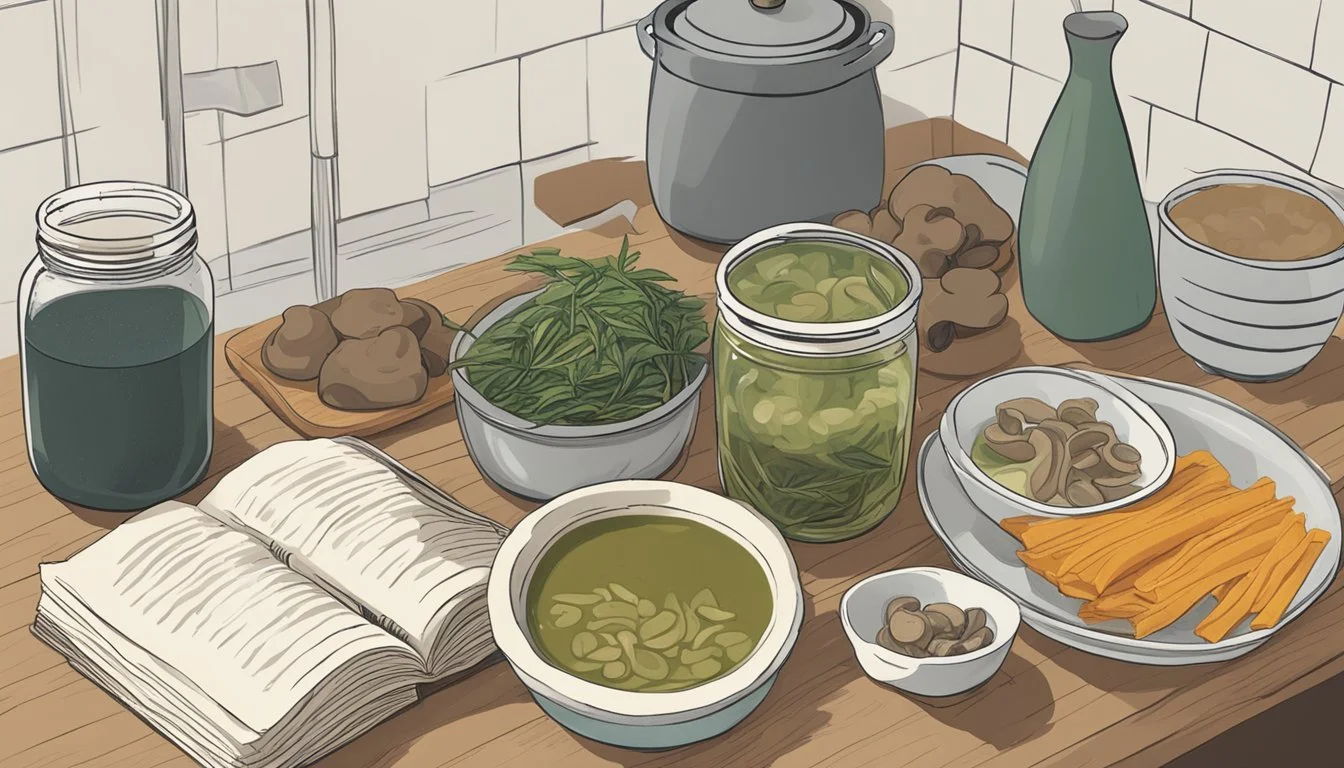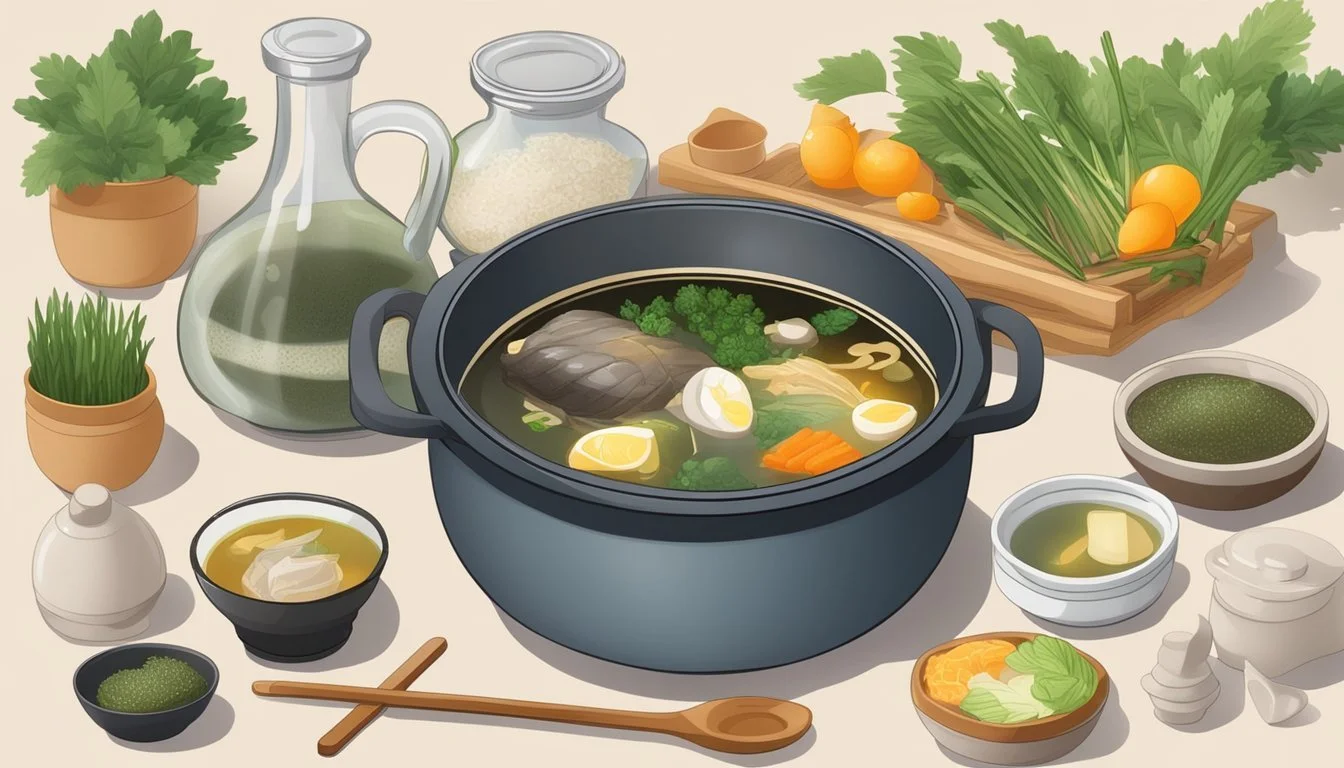How Long Does Kombu Last?
Shelf Life and Storage Tips
Kombu (how long does kombu last?), a type of edible kelp, is a cornerstone in Japanese cuisine, revered not just for its umami flavor but also for its nutritional benefits. This marine vegetable is harvested from kelp forests and is a versatile ingredient in a range of dishes, most famously as the foundation for dashi, the essential broth base that delicately flavors much of Japanese cooking. Outside of its gastronomic importance, kombu is appreciated for its high iodine content and a unique set of amino acids, minerals, and vitamins that contribute to a balanced diet.
The shelf life of kombu is a question of proper storage and preservation methods. When stored dry in a cool, dark place, kombu can last for several years, maintaining its quality and flavor. This is due to the low moisture content in dried kombu, which inhibits the growth of bacteria and mold. This longevity is a boon for chefs and home cooks alike, ensuring that kombu can be bought in bulk and used over time without concern for rapid spoilage.
Once rehydrated or if purchased fresh, kombu's shelf life is significantly reduced. It is then advisable to use the kelp within a few days, and it should be stored in the refrigerator to maintain its quality. Observing proper storage techniques ensures that this integral component of Japanese cuisine remains a staple in culinary creations, contributing its distinct flavor and health benefits without the worry of early spoilage.
Understanding Kombu
Kombu serves as a cornerstone in Japanese cuisine, both for its culinary versatility and its rich nutritional content. This section dives into what kombu is, its varieties, its role in Japanese cooking, and its nutritional significance.
What is Kombu?
Kombu is a type of edible kelp primarily sourced from the waters of East Asia. In Japan, Korea, and China, it is harvested for its multiple uses in cooking. Kombu comes in several forms, including dried sheets, fresh kombu, powdered varieties, and even as kombu tea.
Types of Kombu
There are several varieties of kombu, each with unique characteristics:
Ma kombu: Thick and has a subtle sweetness, preferred for making dashi.
Hidaka kombu: Softer and more delicate in flavor, often used in broths and stews.
Rausu kombu: Known for its deep umami taste, suitable for various dishes.
Nori: Although not a type of kombu, nori is another seaweed commonly confused with kombu but primarily used for wrapping sushi rather than flavoring dishes.
Kombu in Japanese Cooking
Kombu plays an essential role in Japanese cuisine, imparting a savory umami flavor to dishes. It is the backbone of dashi, a fundamental Japanese broth that forms the base for soups, stews, and sauces. Beyond dashi, kombu can be used to season rice, integrate into salads, or add depth to sauces.
The Nutritional Profile of Kombu
Kombu is not only flavorful but also highly nutritious. It is rich in minerals like iodine, calcium, and magnesium. The seaweed also contains glutamic acid, contributing to its umami flavor. Here's a brief overview of its nutritional benefits:
Iodine: Vital for thyroid function and metabolism.
Calcium & Magnesium: Essential for bone health and muscle function.
Glutamic acid: Enhances flavor and supports brain function.
The consumption of kombu must be balanced, especially considering its high iodine content, to avoid potential dietary excess.
Shelf Life of Kombu
Kombu, a type of kelp commonly used in Japanese cuisine as both a flavoring agent and nutritional ingredient, has a significant shelf life when stored properly. It is typically found dried, making it a convenient pantry item for enhancing dishes such as noodle soups.
Average Expiration Date
Dried kombu has an average expiration date ranging from 18 to 24 months when it is unopened and stored in optimal conditions. This lengthy shelf life allows it to retain its quality over time, assuming proper storage practices are followed.
Factors Affecting Kombu's Shelf Life
The longevity of kombu can be influenced by several factors:
Storage environment: Kombu should be kept in a cool, dry place away from direct sunlight.
Packaging: Upon purchasing, it is important to ensure that kombu is in airtight packaging. Once opened, it should be transferred to a resealable bag or a container with a tight-fitting lid.
Humidity: Excess moisture can greatly reduce the shelf life of kombu and lead to spoilage.
Signs of Spoilage
When assessing kombu for freshness, one should look for:
Mold: Any visible mold growth indicates that the kombu has spoiled and should not be consumed.
Unusual odors: A noticeable off smell is a clear sign of spoilage.
Texture change: If the kombu loses its typical dryness and becomes slimy, this is symptomatic of spoilage.
By understanding and recognizing these key points, consumers can ensure they use kombu at its peak quality and prevent unnecessary waste due to spoilage.
Storing Kombu
The longevity and freshness of kombu primarily depend on how it is stored. Maintaining optimal conditions is key to preserving its quality and nutrients.
Optimal Storage Conditions
For unopened kombu, a cool, dry place away from direct sunlight is essential. Most commonly found in dried form at grocery stores, kombu should be transferred to an airtight container after opening to prevent moisture absorption. It's important to avoid areas with high humidity or changes in temperature.
Temperature: Room temperature, around 68°F (20°C), is ideal before opening.
Light: Store in a dark cupboard or pantry.
Moisture: Keep it dry to prevent mold growth.
Increasing Longevity
Proper storage techniques can extend the shelf life of kombu significantly. In refrigeration, opened kombu can last without significant quality degradation.
Refrigeration: Once hydrated, kombu should be kept in the refrigerator, where it will last for up to a week.
Freezing: For long-term storage, vacuum sealing and freezing kombu may extend its life even further.
Expiration Date: Always check package dates, and aim to use kombu before this date to ensure peak flavor and nutrient retention.
Utilizing these storage methods, individuals can ensure that their kombu remains a high-quality ingredient for their culinary needs.
Using Kombu in Recipes
Kombu plays a significant role in Japanese and Korean cuisines as a source of umami flavor, made from a specific type of kelp. It is an ingredient used to enhance numerous dishes with its savory taste.
Enhancing Dishes with Umami Flavor
Kombu is rich in glutamate, an amino acid that contributes to the umami flavor profile found in many Asian dishes. It is traditionally used to prepare dashi, a Japanese soup stock integral to dishes such as miso soup, noodle soup, and tofu soup. The natural umami essence drawn from kombu deepens the flavor of broths and stews without overpowering the other ingredients.
Common Japanese dishes featuring kombu include:
Dashi (Japanese soup stock)
Miso soup
Simmered tofu dishes
Vegetable stews
Additionally, one can add kombu to beans to mitigate gas production and complement the beans' earthy flavors.
Substitutes for Kombu
Finding a substitute for kombu may be necessary for some recipes, especially outside of Asia where kombu isn't readily available. Wakame and nori are two types of seaweed that, while not identical, can impart a similar marine flavor to dishes. However, these substitutes lack the same level of glutamate present in kombu and therefore offer a milder umami experience.
Substitute proportions:
Wakame: Use at a 1:1 ratio, keeping in mind it has a slightly sweeter taste.
Nori: Due to its stronger flavor and different texture, use sparingly.
Preparing Dried Kombu
Dried kombu should be rehydrated before use to maximize flavor extraction. This step typically involves soaking the dried kelp in water for 15-20 minutes, then simmering it at medium heat until its savory taste has been released into the liquid. The kombu is then removed and can often be reused in other dishes, such as by adding it to legumes like beans for added flavor and improved digestibility.
Steps for preparing dried kombu:
Soak kombu in cold water for 15-20 minutes.
Bring the water to a simmer over medium heat.
Remove kombu once the umami flavor has suffused the water.
Remember to store dried kombu in a cool, dry place, away from direct sunlight and in an airtight container, to maintain its quality and extend its shelf life up to a year.
Miscellaneous Uses of Kombu
Kombu is not only a fundamental ingredient in creating stocks but also serves as a versatile element in various culinary processes. Its organic qualities add depth of flavor and can be adapted to different cooking techniques.
Kombu in Pickling and Tsukudani
When pickling vegetables, kombu's natural glutamates enhance the flavour profile, offering an umami richness to the condiment. Pickling with kombu involves adding small strips to the pickling brine, thereby infusing the vegetables with its subtle taste.
On the other hand, tsukudani is a method where kombu is cooked in soy sauce and mirin until it turns into a jam-like consistency. This condiment is rich in flavour and can be used as a savory spread or as an accompaniment to rice.
Kombu as a Garnish
Thinly sliced kombu can make an elegant and flavor-enhancing garnish on various dishes. Its use is not merely decorative; as a garnish, kombu introduces an additional layer of taste, tying together the main components of a dish with its savory umami characteristics. In some dishes, crispy dried kombu may add not only flavour but also texture.
Kombu-derived Products
Kombu, a key ingredient in Japanese cuisine, especially from the Hokkaidō region, is not only used for soups and broths but also serves as the base for various fermented and non-fermented beverages that offer a range of flavors and benefits.
Kombucha and its Varieties
Kombucha is a fermented tea known for its effervescence and tart taste, which results from the fermentation process involving a symbiotic culture of bacteria and yeast (SCOBY). This beverage, often made with kombu as an ingredient, sees variations in flavor based on the type of tea and additional flavorings used. Homemade kombucha can differ in terms of carbonation levels and may contain sediments due to the fermentation process. It can also contain traces of alcohol, as this is a natural byproduct of fermentation.
Japanese Kombucha: Typically non-fermented and made directly from kombu.
Western Kombucha: A fermented drink, can be homemade or commercial, often with visible SCOBY sediments.
Kombu Tea
Kombu tea is a different beverage from the effervescent and sometimes alcoholic kombucha. It is a simple, non-fermented drink where the dried kelp, specifically Haidai from the Hokkaidō region, is steeped in hot water resulting in a mild, savory flavor. Kombu tea is appreciated for its health benefits and is often consumed within Japanese cuisine contexts. Divers ethically source kombu from the coastal areas to be dried and processed into tea form.
Preparation: Steeping dried kombu in hot water.
Flavor: Savory with a subtle ocean taste, no effervescence or tartness.
These kombu-derived products showcase the versatility of kombu, whether used in its dried form or as part of a more complex fermentative process, highlighting its integral role in traditional and modern culinary practices.







